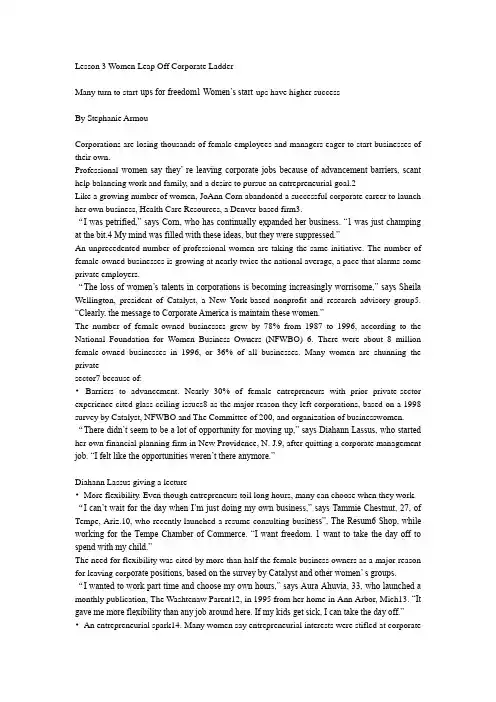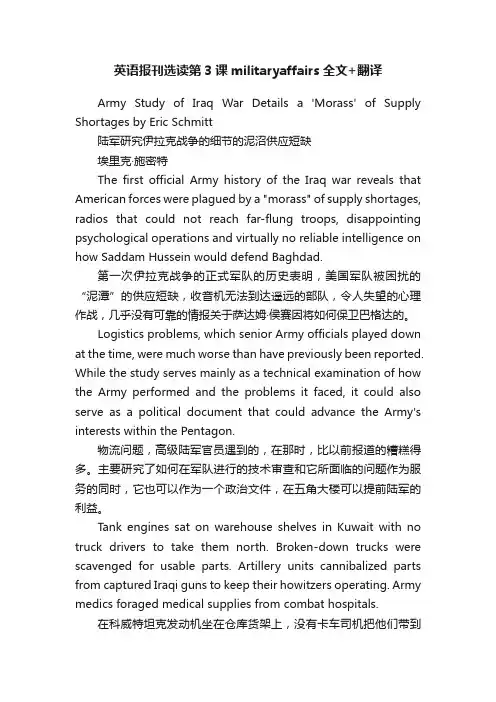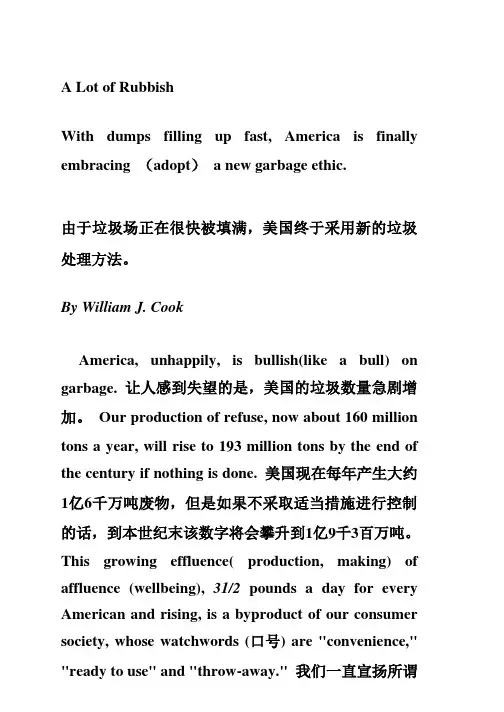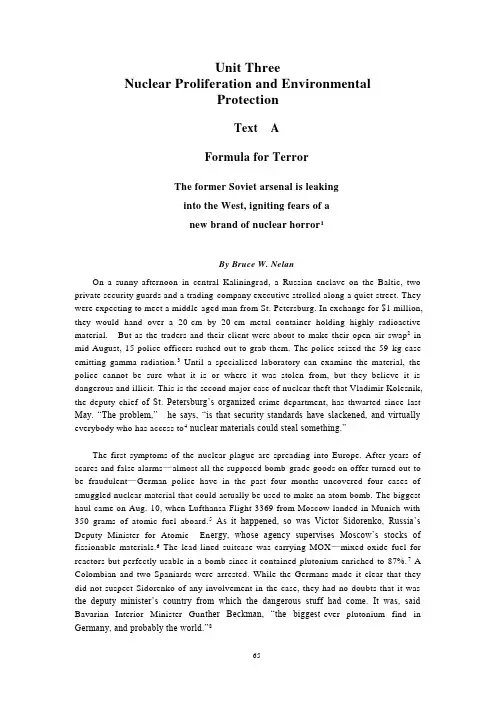美英报刊阅读lesson 3
- 格式:ppt
- 大小:1.70 MB
- 文档页数:42


Lesson 3 Women Leap Off Corporate LadderMany turn to start-ups for freedom1 Women’s start-ups have higher successBy Stephanie ArmouCorporations are losing thousands of female employees and managers eager to start businesses of their own.Professional women say they’ re leaving corporate jobs because of advancement barriers, scant help balancing work and family, and a desire to pursue an entrepreneurial goal.2Like a growing number of women, JoAnn Corn abandoned a successful corporate career to launch her own business, Health Care Resources, a Denver-based firm3.“I was petrified,” says Corn, who has continually expanded her business. “1 was just champing at the bit.4 My mind was filled with these ideas, but they were suppressed.”An unprecedented number of professional women are taking the same initiative. The number of female-owned businesses is growing at nearly twice the national average, a pace that alarms some private employers.“The loss of women’s talents in corporations is becoming increasingly worrisome,” says Sheila Wellington, president of Catalyst, a New York-based nonprofit and research advisory group5. “Clearly, the message to Corporate America is maintain these women.”The number of female-owned businesses grew by 78% from 1987 to 1996, according to the National Foundation for Women Business Owners (NFWBO) 6. There were about 8 million female-owned businesses in 1996, or 36% of all businesses. Many women are shunning the privatesector7 because of:•Barriers to advancement. Nearly 30% of female entrepreneurs with prior private-sector experience cited glass-ceiling issues8 as the major reason they left corporations, based on a 1998 survey by Catalyst, NFWBO and The Committee of 200, and organization of businesswomen. “There didn’t seem to be a lot of opportunity for moving up,” says Diahann Lassus, who started her own financial planning firm in New Providence, N. J.9, after quitting a corporate management job. “I felt like the opportunities weren’t there anymore.”Diahann Lassus giving a lecture•More flexibility. Even though entrepreneurs toil long hours, many can choose when they work. “I can’t wait for the day when I’m just doing my own business,” says Tammie Chestnut, 27, of Tempe, Ariz.10, who recently launched a resume consulting busi ness”, The Resum6 Shop, while working for the Tempe Chamber of Commerce. “I want freedom. 1 want to take the day off to spend with my child.”The need for flexibility was cited by more than half the female business owners as a major reason for leaving corp orate positions, based on the survey by Catalyst and other women’ s groups.“I wanted to work part time and choose my own hours,” says Aura Ahuvia, 33, who launched a monthly publication, The Washtenaw Parent12, in 1995 from her home in Ann Arbor, Mich13. “It gave me more flexibility than any job around here. If my kids get sick, I can take the day off.”•An entrepreneurial spark14. Many women say entrepreneurial interests were stifled at corporatejobs.“As you get larger, it’s really a struggle to think outside the box15,” says Lois Haber, CEO of Delaware V alley Financial Services in Berwyn, Pa.16, which uses a focus group to foster creativity. “You just want to get the work done.”Female-owned firms generate about $2.3 trillion in revenue, a 236% jump from 1987 to 1996. Female business owners employ about 18.5 million people, which means one out of every four company workers in the USA is at a female-owned firm. “The rise in women entrepreneurs is one of the big demographics changing our society,” says Ly nn Neeley, president-elect of the United States Association for Small Business and Entrepreneurship.Female entrepreneursAnd it’s an issue causing mounting concern for private employers trying to hold onto top hires17. Deloitte & Touche, for example, started programs such as flexible work arrangements to help stanch turnover. Others are taking advantage of the disillusionment: McDonald’s ads woo franchisees with the slogan “Golden Arches, not glass ceilings.”18“Women starting businesses today compared to 20 years ago are more likely to leave because they’re frustrated,” says Julie Weeks, research director at NFWBO. “Those are the kind of employees companies would love to keep.”But going solo is no guarantee of success.19 Women report they struggle to be taken seriously. Hours can be grueling. Failure rates are high.While start-ups often have a shaky future, there is promise. Female-owned businesses are more likely to remain in operation than the average firm. The fastest growth today among female-owned firms includes manufacturing, construction, whole-sale distribution and agribusiness.“They see an opportunity to make a difference and become involved,” says Sharon Hadary, executive director of NFWBO. “Not only do we have more women-owned business, the businesses we have are more sophisticated and larger. The businesses themselves are becoming more substantial.”The Small Business Administration reports that nearly three-fourths of female-owned firms launched in 1991 were still operating three years later, vs. two-thirds of all companies.“The biggest obstacle is they’re not taken seriously,” says Phyllis Hill Slater, president of the National Association of Women Business Owners. “I tell women, ‘The more money you earn the more seriously you’ 11 be taken.’ ”Worth the riskMany women feel it’ s worth the gamble. Just last month, Geraldine Laybourne, the president of Walt Disney’ s20 cable networks, said she will leave to start a firm producing shows for women and children.Studies show women take greater risks. According to a survey, 59% of male business owners polled are in a business closely related to previous careers, while 56% of the women own businesses either totally unrelated to previous careers or that had been a personal interest.The shifts can be dramatic. Gail Johnson quit a job as a systems programmer to start Lasting Impression, which helps clients with presentation skills and business etiquette.21“This was always my love,” says Johnson, 50, of Lafayette, Calif.22 “It seemed appealing to be in charge and in control. You’ re out on a limb23 more and you have to wear many hats24, but I love it.”And today’s female entrepreneurs are more apt to be former managers and executives, reflectingwomen’ s advancement over the years.“I kept thinking, ‘Why am I making all this money for someone else?’” says Nina McLemore, who in 1995 co-founded Regent Capital Partners—an equity and debt investment firm—after being president of Liz Claibourne Accessories25.Business experts say companies will continue losing professional women if they don’t do more to encourage them to stay. They suggest retention and mentoring programs, flexible scheduling and a willingness to encourage creativity.Some women say nothing would entice them back. Sharon Fein, 41, started her travel agency instead of taking a management job with a large travel firm.“They wanted me to work more and longer hours for less pay. That’s management,” says Fein of Walnut Creek, Calif.26 “That wasn’ t going to do it. I felt like I didn’ t have a choice.It’ s not without challenges, but it’ s gone very well.”From USA Today, June 9, 1998V. Analysis of Content1. According to this article, private employers __________A. are indifferent to the leaving of top female employeesB. are trying to hold onto female employeesC. have done nothing to attract the femalesD. can easily find male employees to replace female hires2. According to this article, which of the following statements is wrong ?A. Today, female-owned firms are more likely to remain in operation than the average firm.B. The failure rate of female-owned firms is lower than that of the average firm.C. In comparison to men, women take fewer risks in starting a business.D. More than half of female owners are in a business irrelevant to previous careers.3. The sentence “… you have to wear many hats, …” in the last paragraph means ___________.A. you have to put many hats on your headB. you have to take up many responsibilitiesC. you have to take many risksD. you will feel cold at a high position4. The central idea of this article is that__________.A. private employees should do more to encourage their female employees to stayB. women are more independent in the business worldC. female-owned companies are more robust than the average firmD. it ‘ s a growing trend for women to leave corporate jobs to start their own businesses VI. Questions on the Article1. According to this article, what causes professional women to leave their corporate jobs?2. What was the major reason for 30 percent of women’ s decision to leave corporations?3. What does “More flexibility” in this article refer to?4. According to the article, is it easy for women to run their own business?Topics for Discussion1, Do you think it is a good phenomenon that women start their own businesses?2. Do you think that women in the United States enjoy equal treatment as men?。





英语报刊选读第3课militaryaffairs全文+翻译Army Study of Iraq War Details a 'Morass' of Supply Shortages by Eric Schmitt陆军研究伊拉克战争的细节的泥沼供应短缺埃里克·施密特The first official Army history of the Iraq war reveals that American forces were plagued by a "morass" of supply shortages, radios that could not reach far-flung troops, disappointing psychological operations and virtually no reliable intelligence on how Saddam Hussein would defend Baghdad.第一次伊拉克战争的正式军队的历史表明,美国军队被困扰的“泥潭”的供应短缺,收音机无法到达遥远的部队,令人失望的心理作战,几乎没有可靠的情报关于萨达姆·侯赛因将如何保卫巴格达的。
Logistics problems, which senior Army officials played down at the time, were much worse than have previously been reported. While the study serves mainly as a technical examination of how the Army performed and the problems it faced, it could also serve as a political document that could advance the Army's interests within the Pentagon.物流问题,高级陆军官员遇到的,在那时,比以前报道的糟糕得多。

A Lot of RubbishWith dumps filling up fast, America is finally embracing (adopt)a new garbage ethic.由于垃圾场正在很快被填满,美国终于采用新的垃圾处理方法。
By William J. CookAmerica, unhappily, is bullish(like a bull) on garbage. 让人感到失望的是,美国的垃圾数量急剧增加。
Our production of refuse, now about 160 million tons a year, will rise to 193 million tons by the end of the century if nothing is done. 美国现在每年产生大约1亿6千万吨废物,但是如果不采取适当措施进行控制的话,到本世纪末该数字将会攀升到1亿9千3百万吨。
This growing effluence( production, making) of affluence (wellbeing), 31/2 pounds a day for every American and rising, is a byproduct of our consumer society, whose watchwords (口号) are "convenience,""ready to use" and "throw-away." 我们一直宣扬所谓的“便捷”“方便”和“一次性”,现在平均每个美国人每天产生3.5 磅并且该数字一直还在增加,富足的生活产生的垃圾,是我们这个消费社会的副产品。
And it has become a major national environmental issue, forcing citizens, elected officials and private companies to give serious thought to rubbish. 已经成为一个举国关注的焦点问题,迫使市民,政府官员以及私营公司齐心应对垃圾处理问题。



Unit ThreeNuclear Proliferation and EnvironmentalProtectionText AFormula for TerrorThe former Soviet arsenal is leakinginto the West, igniting fears of anew brand of nuclear horror1By Bruce W. NelanOn a sunny afternoon in central Kaliningrad, a Russian enclave on the Baltic, two private security guards and a trading-company executive strolled along a quiet street. They were expecting to meet a middle-aged man from St. Petersburg. In exchange for $1 million, they would hand over a 20-cm by 20-cm metal container holding highly radioactive material. But as the traders and their client were about to make their open-air swap2in mid-August, 15 police officers rushed out to grab them. The police seized the 59-kg case emitting gamma radiation.3Until a specialized laboratory can examine the material, the police cannot be sure what it is or where it was stolen from, but they believe it is dangerous and illicit. This is the second major case of nuclear theft that Vladimir Kolesnik, the deputy chief o f St. Petersburg‟s organized-crime department, has thwarted since last May. “The problem,” he says, “is that security standards have slackened, and virtually everybody who has access to4nuclear materials could steal something.”The first symptoms of the nuclear plague are spreading into Europe. After years of scares and false alarms—almost all the supposed bomb-grade goods on offer turned out to be fraudulent—German police have in the past four months uncovered four cases of smuggled nuclear material that could actually be used to make an atom bomb. The biggest haul came on Aug. 10, when Lufthansa Flight 3369 from Moscow landed in Munich with 350 grams of atomic fuel aboard.5As it happened, so was Victor Sidorenko, Russia‟s Deputy Minister for Atomic En ergy, whose agency supervises Moscow‟s stocks of fissionable materials.6The lead-lined suitcase was carrying MOX—mixed-oxide fuel for reactors but perfectly usable in a bomb since it contained plutonium enriched to 87%.7 A Colombian and two Spaniards were arrested. While the Germans made it clear that they did not suspect Sidorenko of any involvement in the case, they had no doubts that it was the deputy minister‟s country from which the dangerous stuff had come. It was, said Bavarian Interior Minister Gun ther Beckman, “the biggest-ever plutonium find in Germany, and probably the world.”8Two days later, at a railway station in Bremen, a 34-year-old German man was arrested trying to peddle a sample of plutonium to a journalist acting for the police. The seller had only a very tiny amount, 0.5 gram, but of such startling purity that experts said it probably came from a top-of-the-line9Russian nuclear laboratory. Senior officials in Moscow reacted defensively, insisting that all their plutonium was accounted for and safely under guard.10The accusation from Germany, blustered Deputy Atomic Energy Minister Yevgeni Mikenin, “is a provocation of the purest water.”11The world…s first notice that weapons-grade plutonium was on the open market came in southern Germany last May, when 6 grams were found in a garage owned by a German businessman who had been arrested for counterfeiting.12That was followed in June by recovery of less than a gram of highly enriched uranium—probably fuel from a nuclear- powered submarine in Landshut. Even if all this smuggled booty were put together, there would not be enough for the smallest and crudest atom bomb, which in the hands of inexperienced makers would take about 8 kg of plutonium.13Even so, the emergence of a black market for the essential material of mass destruction is a historic and nightmarish challenge for the world.14It makes the threat of nuclear proliferation15 far more urgent and increases the number of characters who could do it themselves. “We‟ve crossed a thresh old. You smuggle small amounts of the stuff often enough, and you‟ve got a bomb,” says Leonard Spector, director of the nonproliferation project at Washington‟s Carnegie Endowment for International Peace.16 The arrival of these nuclear samples on the German market is a red alert, raising immediate questions about what is happening in other countries and who the potential users might be. If such snippets are on sale in Germany, what larger deals might be going undetected elsewhere? If bomb-grade plutonium is finally on sale, will a rogue state or terrorist group step up to buy enough to build a bomb?Such fears have a foundation: the world has seen terrorism continuously evolve to new heights of ingenuity and depravity. This week Carlos the Jackal17 is in jail in France, and North Korea is using the threat of nuclear weapons to try to extort billions from its neighbors. Their juxtaposition in the news, linking the worst of 1970s-style terrorism with the brazen threat of irresponsible nuclear ambitions, shouts a warning of a different sort of terror, still indefinable but extremely frightening.18The combination of brutality and fanaticism with nuclear weapons could bring about disasters almost too chilling to contemplate.The old wave of terror, personifi ed by Ilyich Ramirez Sanchez, is ebbing. “Carlos,” says Paul Wilkinson, an expert on terrorism at St. Andrews University in Scotland, “symbolized a terrorism of the extreme left which has almost died out in Europe.” Carlosand his Soviet, Marxist and leftist Palestinian allies represent failed ideologies. The inheritors today are nameless Islamic extremists from Hizballah,19Hamas20and their sponsors—everyone thinks first of Iran as chief sponsor—who see themselves as the force of the future in the Middle East. While their cause is the same—derailing the peace process and destroying Israel—the Islamists21do not need a secular professional like Carlos.Nuclear weapons in the hands of extremists willing to use them would produce terrorism of a wholly new magnitude. The central logic of terrorism is to maximize horror and shock, producing a blaze of publicity and attention for the cause it represents. By that measure, the crudest of fission bombs set off in a modern city, vaporizing entire blocks, would make the crimes of Carlos and his ilk rank as little more than pinpricks.22Who are the sellers? Beyond terrorism, if significant amounts of plutonium are beginning to flow from Russia, they could make the development of nuclear weapons much easier for states that up to now have found bomb programs too expensive and technically beyond their capabilities. Countries such as North Korea and Pakistan, which have some plutonium of their own, as well as countries such as Iran and Libya that would like to, might be gin to look seriously at what is on offer in the new marketplace. “There is already far more bomb-quality nuclear material23in Germany than the authorities can imagine,” said Russian atomic expert Vladimir Chernosenko, who was one of the officials charged with cleaning up the Chernobyl nuclear accident.24 “If economic conditions in Russia do not improve soon, there will be an outflow organized from the highest echelons.”25To help prevent that, German Chancellor Helmut Kohl sent intelligence coordinator Bernd Schmidbauer to Moscow on Saturday to talk with President Boris Yeltsin about ways to tighten controls over nuclear stocks. “We have to tell our Russian friends,” said Kohl, “ you must guarantee that these possibilities for theft are reduced as much a s possible.”Some Russian officials continue to deny that their facilities are the source of the leaks into Germany. “Not a single gram of plutonium-23926is missing from storage,” a spokesman for the Federal Counterintelligence Service insisted last week. “Our storage system is as reliable as a bank vault,”27claimed Alexander Rumyantsev, director of the Kurchatov Institute, a leading nuclear laboratory in Moscow.Conditions in Russia more closely resemble a bazaar than a bank. Industry and most sectors of the economy are tottering; workers are mostly unpaid. Poor people are inventive, goes a Russian proverb, and the poorer they are the more inventive they become. Among the most aggrieved are the 100,000 workers employed in national nuclear plants and laboratories, whose salaries have slid to $100 a month—or no pay at all for months at a time. So almost anything is for sale. Last year Russian police acknowledged thwarting11 attempts to steal uranium from nuclear installations.28Other attempts may have succeeded, as nuclear workers grew increasingly desperate. At Krasnoyarsk-26, a factory producing weapons-grade plutonium, employees mounted a protest last month, demanding salaries that had not been paid since May. Russian Prime Minister Viktor Chernomyrdin then had to rush to Arzamas-16, where nuclear warheads are being disassembled, to head off a similar kind of unrest.29What makes the disarray so frightening is the staggering amount of dangerous radioactive material all over Russia. Experts there say the old Soviet weapons complex produced more than 140 metric tons of plutonium. The stockpiles of highly enriched uranium, which can also be used to make bombs, total about 1,000 metric tons.Under strategic-disarmament treaties30with the U.S., Russia is dismantling about 2,000 warheads a year, recovering shiny, fist-size spheres of plutonium called pits —the elemental core of a bomb —which it is putting into storage. A purchaser who acquired one of these would have the key ingredient of a bomb. Over the next 10 years, the U.S. and Russia will take 100 metric tons of plutonium out of warheads, and their nuclear-power industries will produce an additional 110 tons. By then there will be enough plutonium in storage worldwide to build 42,000 atom bombs.Some Western estimates put Russia‟s current stock of plutonium at 200 tons. The military weapons, including all those pits, are still under tight security —as far as anyone knows. But other forms of plutonium are scattered all over the country in resea rch institutes, laboratories, reprocessing31 plants, shipyards and power stations, where security is believed to be lax and accounting is unreliable.With big money presumably to be made in the plutonium trade, some thefts will be inside jobs.32Deputy Interior Minister Mikhail Yegorov told Western officials at a conference in Germany that he believed the 6 grams of plutonium found in that country in May had been stolen by officials of the Russian Atomic Energy Ministry. In other cases, Russian gangsters33will step in and bribe or coerce34those with access to fissionable materials to steal them.When FBI director Louis Freeh visited Moscow last month, he told cadets and faculty of the Russian Police College that “one criminal threat looms larger than the others: the theft or diversion of radio-active materials in Russia and Eastern Europe.”35 Organized-crime groups, he warned, would try to obtain such materials “to be offered for sale to the highest bidder.” The Russian daily Izvestia36makes the same judgment. It reported recently that more than 5,500 criminal gangs were operating in Russia, and “the lion…s share of37their operations involve stealing fissionable nuclear materials and smuggling them out.”Who are the buyers? The rise of the illegal commerce suggests that there are serious bidders out there. But there is no evidence indicating who they are. Three of the foursamples of weapons materials that turned up in Germany were purchased by undercover agents in sting operations38designed to trap the sellers or their countries. Indeed, in the Bremen episode, the defendant‟s lawyer claims that his client too is a police operative. There have been rumors in Germany, but no proof, that the 6 grams found in May were acquired for a foreign government, possibly Iraq or North Korea. In fact, there is no evidence yet that anyone in Germany was buying or prepared to buy nuclear material except the police.When the first samples of low-grade nuclear material began to leak out of former Warsaw Pact Countries39 in 1991, the German police sent special squads into the field to find them. Since 1991, German police have counted 440 cases of nuclear smuggling, and almost all have been stings. With so many agents posing as buyers, some skeptical officials wonder if they might be creating a demand.40“There‟s no evidence of a real market for plutonium in Germany,” says Bremen‟s chief prosecutor. He wonders whether “our interest in pursuing criminals is bringing danger into Germany.”Yet the spectacle of apparent amateurs in the plutonium business getting their hands on the real thing could bring about serious conspirator onto the scene with big money. How big the money has to be is still unanswered because no deals outside police scams41 have come to light.42 Even so, the price of enough plutonium to make a bomb would have to be in the millions of dollars or tens of millions. It is doubtful that any terrorist group has that kind of financing. Even Hizballah, the extremist group most directly linked to a state sponsor, cannot expect to receive tens of millions for its own purchases from an Iran that is struggling to arm itself.Nor is a radical state like Iran, Libya or Iraq likely to buy a bomb and hand it over to terrorists. “If you just spent $300 million on something,” ask s a U.S. State Department specialist, would you turn it over to a band of terrorists “or would you keep it for your own protection?” He also wonders if Iran could keep secret forever the transfer of a nuclear weapon to Islamic militants. Teheran would have to be certain it did not leave fingerprints on the deal, or the country could become the target of reprisals—possibly nuclear.43“God help the state that gave terrorists nuclear material,” says the official. “The international community‟s response would be dramatic.”Yet the mere fact that plutonium is on the market could conceivably lend credibility to terrorist groups that might try to persuade people they have built a bomb.44“The problem now,” says Richard Guthrie of the Verification Technology Infor mation Center,45 a nonprofit group in London, “is blackmail. If someone says he‟s built a bomb in a basement somewhere, how does a government react when that person produces a gram or so of weapons-grade material to prove the threat?”While the ultimate horror would be a working bomb constructed by terrorists on theirown, the much likelier catastrophe46 is a large purchase of plutonium by a country looking for a shortcut to a nuclear arsenal. “It‟s clear that the highest bidder is going to be a state,”says Phebe Marr, an expert on Iraq at the National Defense University in Washington. A government with nuclear ambitions would want not just a single bomb but an arsenal or significant additions to an existing arsenal. One or two bombs could attract threa ts and retaliation from abroad. So an interested state would be in the market for tens or hundreds of kilograms of plutonium —and that amount would be extremely expensive.Experts in the Middle East suggest that only Iran—in addition to Israel—is believed to be actively pursuing nuclear weapons. In spite of its severe problems of debt and unemployment, the Iranian government has not reduced its spending on arms programs. “Iran wants to be the most powerful military presence in the gulf,” says Mourad El-Desouky, a military expert at Al Ahram Strategic Studies Center in Cairo. “It wants nuclear weapons for deterrence47and to intimidate its neighbors.” He believes that the Iranians have the money to go shopping for plutonium and weapons-grade urani um from Russia‟s black market in Western Europe, and “it‟s realistic to think they are doing that.”Who can control it? Policymakers and scientists in the West hope to persuade the Russians to take steps that would head off the proliferation of weapons of mass destruction.48 On this score, the U.S. has often talked a better game than it has played. In 1991 the U.S. Congress authorized the Bush Administration to spend $400 million a year for three years to help the former Soviet republics keep nuclear materials and facilities secure. So far, in part because of congressional inaction, about $500 million of the first $900 million authorized has not been spent. Among the projects held up: a Pentagon-organized training course for border-control officials of the former Soviet Union.The National Academy of Sciences looked at the plutonium piling up in the U.S. and Russia and this year recommended concrete steps to take it out of circulation. Since the outright destruction of plutonium is problematic and prohibitively expensive, the academy suggested mixing it with other nuclear wastes and molten glass, creating radioactive glass logs weighing an unusable two tons. These would be stored in deep holes. It also proposes combining plutonium with uranium to make reactor fuel, which after use will leave the plutonium locked into containment fuel rods.49The main problem with such ambitious ideas is that the Russians want no part of them.50In general, there is enough suspicion left over from the cold war to make Russian nuclear officials determined to keep Americans from getting anywhere near their plutonium stocks. More specifically, the Russians view their plutonium as a national treasure, and they don‟t propose to do away with it.Rather, they want to store their plutonium to use later as fuel in a new generation of breeder reactors, which they hope to have up and running in about 20 years.51 They intend to keep their tons of shiny plutonium warhead pits in storage until then—even at a cost they estimate at around $2 per gram per year. The new reactors will be hugely expensive too, and the floundering Russian economy may not be able to afford them. Then the plutonium will be little more than an immense security problem, requiring protection against theft and diversion for about 25,000 years—the half-life of plutonium. It would be better if the experts could get to work on a solution before the huge stockpile…s still-small leaks turn into a flood that could engulf the world.TIMEAugust 29, 1994BACKGROUND1. None of the uranium and plutonium seized so far has been the type that could easily be turned into a bomb. The amounts were too small even for a bomb maker equipped with all the sophisticated gadgetry to make an explosive device.But the materials can be lethal. A tiny amount of plutonium can cause lung cancer if inhaled. Containers holding the materials could break in a crowded airport; contaminating could occur if couriers driving a consignment were involved in car crash.Nuclear materials can be easily transported. Uranium can come in the form of small pellets and plutonium as oxide powder or liquid. Both can be carried in a glass jar or a metal can.Seizures in Germany, Russia, Hungary, Bulgaria and Romania in 1994 have caused genuine fears that guerrillas could use just a few grams to threaten targets and governments.One thing is already clear. Nuclear trafficking took off when the Soviet Union crumbled in 1991, the end of the Cold War sending a fresh chill blowing through the West.“Most of the nuclear materials are coming from the successor republics of the Sovi et Union,” said a diplomatic source close to the International Atomic Energy Agency (IAEA.)The IAEA moved quickly in the early 1990s to provide help and cash to the Soviet Union‟s newly independent states to track down their nuclear stocks and set up stat e systems of accountancy and control.2. The Nuclear Non-Proliferation Treaty(NPT) was made permanent in May, 25 years after it entered into force. The four-week Conference on the Review and Extension of the NPT (held in New York April 17 to May 12) was the largest arms control conference ever held, with 175 of the treaty…s 178 parties participating. No state got all it wanted, although the weapon states had more reason to be satisfied than the non-weapon states.The United States, Russia, Britain, and France wanted the treaty extended indefinitely and unconditionaly. Only the first part of their wish was fully granted.A core group of 14 non-aligned states, led by Indonesia, wanted the treaty extended for a series of rolling fixed periods of 25 years, subject to reaching certain goals during each time period. The 14 non-aligned states didn‟t get their 25-year rolling extensions. Texts adopted at the conference at least implied some degree of conditionality as well as greater accountability by the nuclear powers.The Arab states, led by Egypt, refused to endorse any proposal for the extension of the NPT, unless pressure was brought on Israel to accede to the NPT and accept full-scope safeguards. Although the Arab states didn…t get that, they got language that urged all states in the Middle East to join the NPT.China was willing to accept either an indefinite extension or multiple fixed extensions of no less than 25 years. By playing both sides of the extension issue, it insure itself a strong voice with the nuclear powers and with the non-aligned nations.Excerpts from The Bulletin of the Atomic ScientistsJuly/August 19953. The Treaty on the Non-Proliferation of Nuclear Weapons (NPT) has played apositive role in containing nuclear weapons proliferation and China supports its smooth extension, Vice-Premier Qian Qichen said in the United Nations on April 18, 1995.Qian, who is also China‟s foreign minister, said China supports the three major objectives of the treaty: promotion of nuclear disarmament, prevention of nuclear proliferation and enhancement of international cooperation for peaceful uses of nuclear energy. To reaffirm the three objectives of the treaty in the new situation will contribu te to the maintenance of international peace, security and stability.The Chinese foreign minister stressed in his speech that prevention of nuclear weapons proliferation is not an end in itself, but an intermediate step leading towards the ultimate objective of complete and thorough destruction of nuclear weapons.The NPT, went into effect in March 1970 for a period of 25 years. China acceded to the treaty in March 1992.4. A priority for the United States is to stem the proliferation of nuclear weapons andother weapons of mass destruction and their missile delivery systems. Countries‟ weapons programs, and their levels of cooperation with our nonproliferation efforts, will be among our most important criteria in judging the nature of our bilateral relations.As a new part of our effort to control nuclear proliferation, we seek the indefinite extension of the Non-Proliferation Treaty beyond 1995 and its universal application. Achieving a Comprehensive Test Ban Treaty as soon as posible, ending the unsafeguarded production of fissile materials for nuclear weapons purposes and strengthening the NuclearSuppliers Group and the International Atomic Energy Agency (IAEA) are important goals. They complement our comprehensive efforts to discourage the accumulation of fissile materials, to seek to strengthen controls and constraints on those materials, and over time, to reduce world-wide stocks.The proliferation problem is global, but we must tailor our approaches to specific regional controls. We are leading international efforts to bring North Korea into compliance with its nonproliferation obligations, including the NPT, IAEA safeguards, the North-South denuclearization accord. We will continue efforts to prevent Iran from advancing its weapons of mass destruction objectives and to thwart Iraq from reconstituting its previous programs. The United States seeks to cap, reduce and ultimately eliminate the nuclear and missile capabilities of India and Pakistan. In the Middle East and elsewhere, we encourage regional arms control agreements that address the legitimate security concerns of all parties. These tasks are being pursued with other states that share our concern for the enormous challenge of stemming the proliferation of such weapons.The United States has signed bilateral agreements with Russia and Ukraine, which commit both these countries to adhere to the guidelines of the Missile Technology Control Regime (MTCR). Russia has agreed not to transfer space-launch vehicle technology with potential military applications to India. We continue to push for the dismantlement of intercontinental ballistic missiles located in Ukraine and Kazakistan and to press China to formalize its earlier MTCR undertakings. With the United States and Russia, Ukraine is pressing forward on implementation of the Trilateral Accord, which provides for the transfer of warheads from Ukraine to Russia in return for fair compensation for their value.The strategic arms control process, with its prescribed reducations in strate gic offensive arms and steady shift toward less destabilizing systems, remains indespensible. The U.S. is committed to the ratification and entry into force of the START I and II Treaties. The U.S. is also reviewing whether future reductions in strateg ic forces below START II levelsare advisable. We will also explore strategic confidence-building measures and mutual understandings that reduce the rise of accidental war.Excerpts fromA National Security Strategy onEngagement and EnlargementThe White HouseJuly 19945. The United States developed the first atomic (unclear) weapons in the 1940s, many other nations have sought unclear arms and the power these weapons represent. However, the dangerous and destabilizing proliferation (spread) of nuclear weapons alarmed the global communi ty. Nevertheless, some nations continue their quest for “the bomb.” The technology to build nuclear weapons is still available, and many countries have the ability to make them or to help others do so. Therefore, international agreements—and the organizations that ensure compliance with such treaties —are important in controlling nuclear proliferation.The 1960s witnessed the progress of the nuclear nonproliferation movement. The United Nations (UN) Nuclear Nonproliferation Treaty, the cornerstone of global efforts to curtail the manufacture of nuclear weapons, entered into force in 1970. The antiproliferation campaign scored a major success in 1996 when United Nations members approved a new treaty to ban all testing of nuclear weapons. However, the campaign to curb the spread of nuclear weapons was dealt a serious setback in May 1998, when bitter rivals India and Pakistan exploded several nuclear devices. Suddenly, the “nuclear club” had two new members.Antiproliferation efforts have also targeted conventional arms. The spread of conventional armaments and the development of unclear weapons are major threats to global stability.The Spread of Nuclear WeaponsThe Atomic Bomb and the United States. In August 1945, the United States dropped atomic bombs on the cities of Hiroshima and Nagasaki, Japan. The attacks led to Japan‟s surrender and the end of World War II.The world had witnessed the awesome power of nuclear technology. Soon after the war, the Untied States proposed to the United Nations that all nuclear technology and materials be controlled by an international agency. The Soviet Union, however, vetoed this proposal and argued for a more immediate destruction of all existing unclear bombs. Because world could not reach an agreement on international control of nuclear weapons. The Soviet Union decided to continue their research on building nuclear devices. U.S. hopes of a nuclear monopoly were shattered when the Soviet Union exploded its first atomic device in 1949. Great Britain followed suit in 1952.An Expanding Nuclear Club.In the early 1960s, both France and China detonated atomic bombs, adding to the number of members in the “nuclear club.” The three original nuclear powers—the United States, the Soviet Union, and Great Britain—worried that even more nations would develop the bomb. They rationalized that as one nation in a particular region went nuclear, its neighbors or rivals would also want similar weapons to avoid or defend against attack, thus increasing the risk of nuclear warfare or accide nts. Many nonnuclear countries resented this assumption, contending that they would be just as careful in their use of nuclear weapons as the original members of the nuclear club.Nonproliferation Treaties. As more nations gained nuclear weapons in the 1960s, the possibility of nuclear confrontation grew. The nuclear powers began a campaign to persuade nonnuclear countries from attempting to acquire nuclear capability.UN Nuclear Nonproliferation Treaty.The1968 UN Nuclear Nonproliferation Treaty was designed to halt the spread of nuclear weapons and promote peaceful uses of nuclear power. It granted all nonnuclear signatories (signers) access to peaceful nuclear technology from participating nuclear powers. The nonnuclear countries had to promise that they would not use the technology to make weapons. The United States, the Soviet Union, and Great Britain signed the treaty, thereby agreeing that they would not help others build nuclear bombs and that they would reduce their nuclear arsenals. In 1995, UN members decided that the treaty should be extended indefinitely. However, Israel and some other nations suspected of having developed nuclear weapons have not signed the treaty.The Limited Test Ban Treaty.From the 1940s through the 1960s, the five nuclear powers—the United States, the Soviet Union, Great Britain, China, and France—conducted explosive tests to develop nuclear weapons and to increase their bombs‟ power. Concerned about environmental damage, in 1963, leaders from these countries signed a treaty to limit the testing of nuclear weapons. The Limited Test Ban Treaty made it illegal to test nuclear weapons in the atmosphere, outer space, and underwater.The Comprehensive Test Ban Treaty.After the Limited Test Ban Treaty went into effect, exploding nuclear weapons underground remained legal. However, by the early 1990s, many world leaders, particularly those from nonnuclear countries, wanted all nuclear blasts to cease. In 1996, more than fifty members of the United Nations signed the Comprehensive Test Ban Treaty, making all forms of nuclear explosions illegal.Future Nuclear Nations. The nuclear club added two new members in May 1998, when India and Pakistan successfully tested several nuclear devices. Iran, Israel, Libya, and North Korea may also have such weapons or may be attempting to make them.The United States, China, France, and Germany have supplied some countries with the knowledge, technology, and materials to construct nuclear reactors for generating electricity. However, the materials and technology sold for peaceful purposes can be used to develop nuclear weapons. Although most nuclear transfers take place under。
电大英语报刊选读课程导学一、课程总的概况课程领域概括这是英语教学中的一门不能或缺的课程。
通过学习本课程,使学生掌握常见报刊词汇,报刊文章标题的翻译,学会看懂较简单的英语报刊文章。
通过阅读英语报刊了解国际时事,了解各国的政治,历史、文化、教育、人民和国家概况等与英语学习有关的背景知识。
以利学生进一步巩固和提高英语学习,培养学生英语阅读的能力。
目标引导本课程的教学目的是通过学生自主学习及教师的导学和助学(包括面授辅导),使学生掌握常见报刊词汇,报刊文章标题的翻译,学会看懂较简单的英语报刊文章。
通过阅读英语报刊了解国际时事,了解各国的政治,历史、文化、教育、人民和国家概况等与英语学习有关的背景知识。
进一步巩固和提高学生英语阅读理解和简单翻译的能力。
二、使用学习资源1.根据主教材学习1.本课程采用的文字主教材为《美英报刊文章阅读》(精选本第二版),及上海电视大学外语系编辑的报刊活页。
本课程教学安排为一学期。
课内学时为72,共4学分,(每周4学时)。
《美英报刊文章阅读》共30课,选其中10为必学内容,其余内容供学生自学,10课必学内容为Lessons1,3,4,8,10,13,14,19,24,26。
以上10课用10周学完。
每周一课。
2.本教材课文并非按语言难易循序渐进,而是按内容编写,学生自学时有一定难度。
学生学习时重点是根据教师的导学,掌握一定的英语报刊常见词汇,基本会看懂报刊文章的大意;通过翻译报刊标题了解报刊大致内容;通过阅读英语报刊文章了解国际时事、各国的历史、文化、风俗、习惯,掌握相关的信息。
因此阅读和理解是重点。
教师助学时应着重帮助学生掌握重点,分析讲解难点,而语法分析、语言点的掌握不作要求。
建议学生在课后以练习为线索,多看看英语报刊文章。
考前复习也是以练习,常见词汇和推荐的英语报刊文章为主。
3.本课程实际是泛读快速阅读训练的混合型课程。
泛读是一门进行大量阅读实践的课程,应该突出"泛"的特点。